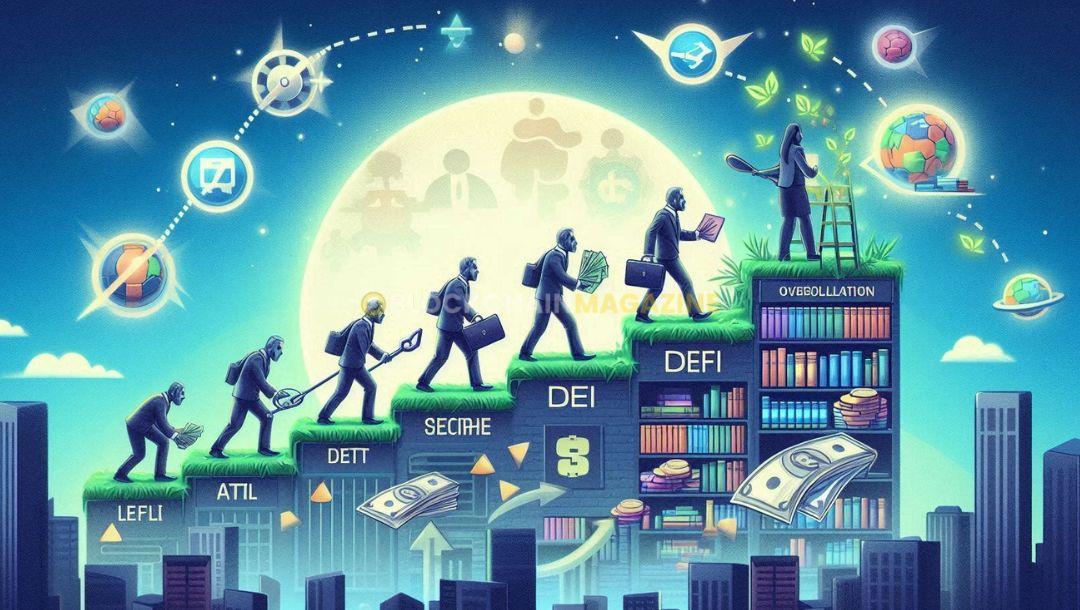The Amazing Evolution of DeFi Lending: From Over-Collateralization to Real-World Asset Integration In 2024
Decentralized finance (DeFi) has revolutionized the financial landscape, offering trustless, permissionless, and transparent financial services powered by blockchain technology. One of the most significant innovations within DeFi is lending, which allows users to borrow and lend crypto assets without intermediaries like banks. DeFi lending protocols such as Aave, Compound, and MakerDAO have democratized access to loans, enabling users to earn yield on idle assets or borrow funds instantly.
However, as DeFi lending evolved, it became apparent that there were limitations in its early forms, particularly the reliance on over-collateralization. Initially, most DeFi loans required borrowers to provide collateral far exceeding the value of the loan, creating inefficiencies and limiting the potential user base. In recent years, the DeFi ecosystem has begun to shift toward integrating real-world assets (RWAs) as collateral, unlocking new opportunities for growth and adoption.
This article explores the evolution of DeFi lending, tracing its journey from over-collateralization to the integration of real-world assets, while examining the implications for the broader financial industry.
The Rise of Over-Collateralized DeFi Lending
When DeFi lending protocols first emerged, they offered a unique alternative to traditional lending systems. Borrowers could obtain loans without the need for intermediaries, extensive credit checks, or centralized control. However, the early iterations of DeFi lending were built on a foundation of over-collateralization, a mechanism designed to mitigate risk in the absence of credit scores or borrower history.
Understanding Over-Collateralization
In over-collateralized lending, borrowers must deposit collateral that exceeds the value of the loan they wish to take out. For example, a borrower seeking a $1,000 loan in a DeFi protocol like Compound might need to deposit $1,500 worth of Ether (ETH) or another cryptocurrency. This over-collateralization acts as a buffer to protect the lender in case the value of the collateral declines or the borrower fails to repay the loan.
The reliance on over-collateralization is a direct consequence of DeFi’s trustless nature. In traditional lending, banks assess borrowers’ creditworthiness based on credit scores, financial history, and income, which helps reduce the risk of default. In contrast, DeFi protocols operate without such systems, relying solely on smart contracts and collateral to secure loans.
Also, read – Top 10 Amazing Ways Blockchain Can Help In Asset Management And DeFi Lending
Benefits of Over-Collateralized Lending
Despite its inefficiencies, over-collateralized lending played a crucial role in the initial growth of DeFi lending. It offered several advantages:
- Trustless and Permissionless: Users could borrow and lend assets without needing to trust centralized institutions or undergo credit checks.
- Global Access: Anyone with internet access and cryptocurrency could participate, enabling financial inclusion on a global scale.
- Instant Liquidity: Borrowers could access loans almost instantly, bypassing the lengthy approval processes associated with traditional loans.
- Transparency: Smart contracts executed the lending agreements, ensuring transparency and reducing the risk of fraud.
Limitations of Over-Collateralization
While over-collateralized lending protocols enabled the rapid growth of DeFi, they also presented several challenges that limited their scalability:
- Capital Inefficiency: Borrowers had to lock up significantly more capital than they borrowed, which was inefficient for users who wanted to leverage their assets.
- Barrier to Entry: Over-collateralization created a high barrier to entry, making DeFi lending inaccessible to users who lacked substantial crypto assets.
- Volatility Risks: Since most collateral was in volatile cryptocurrencies like Bitcoin (BTC) or Ether (ETH), sharp price declines could trigger liquidation events, causing borrowers to lose their collateral.
- Lack of Real-World Integration: The early DeFi lending protocols were limited to crypto assets, excluding the vast market of real-world assets such as real estate, commodities, and invoices.
The Shift Toward Under-Collateralization
Recognizing the limitations of over-collateralized lending, the DeFi space began exploring alternatives that would allow for under-collateralized or even uncollateralized loans, similar to traditional lending. This shift aimed to make DeFi lending more efficient, accessible, and integrated with real-world financial systems.
The Emergence of Under-Collateralized Lending
Under-collateralized lending protocols reduce the amount of collateral required to secure a loan. In some cases, these protocols enable users to borrow more than the value of the collateral they deposit. This shift is made possible through mechanisms that assess borrower risk and reputation, including on-chain credit scores, trust networks, and tokenized credit ratings.
One notable example of under-collateralized lending is TrueFi, a protocol that allows for uncollateralized lending based on borrower reputation. Borrowers on TrueFi are vetted through a rigorous approval process, and lenders rely on borrower reputation and financial metrics to assess risk. While this introduces some centralized elements into the otherwise decentralized DeFi space, it represents a significant step toward making DeFi lending more capital efficient.
Another approach to under-collateralization involves credit delegation, where users with excess collateral delegate borrowing power to trusted third parties. Aave, for example, introduced credit delegation through its “Aave Credit Delegation” system. In this model, a user with deposited collateral can delegate their borrowing capacity to another party, who can then take out a loan without needing to provide collateral themselves. This model leverages social trust and reputation to facilitate under-collateralized lending.
Advantages of Under-Collateralized Lending
Under-collateralized lending introduces several benefits over traditional over-collateralized models:
- Improved Capital Efficiency: Borrowers no longer need to lock up excessive amounts of collateral, freeing up more capital for productive uses.
- Increased Accessibility: Reducing the collateral requirements lowers the barrier to entry for new users, making DeFi lending more inclusive.
- Broader Use Cases: Under-collateralized loans open the door to a wider range of lending use cases, including personal loans, business financing, and working capital.
However, under-collateralized lending also introduces new risks, particularly in terms of borrower default. DeFi protocols must carefully balance risk assessment, reputation management, and decentralized governance to ensure the sustainability of under-collateralized lending.
Real-World Asset (RWA) Integration: The Next Frontier of DeFi Lending
The most transformative development in DeFi lending is the integration of real-world assets (RWAs) as collateral. This shift bridges the gap between the traditional financial system and DeFi, unlocking a vast market of tangible assets that can be tokenized and used in DeFi lending protocols.
What Are Real-World Assets?
Real-world assets refer to physical or traditional financial assets that exist outside the blockchain but can be tokenized and represented on-chain. These assets include real estate, commodities, invoices, bonds, and equities. By tokenizing RWAs, DeFi protocols can extend lending services to include a wider range of collateral types, significantly expanding the market size for DeFi lending.
The Role of Tokenization
Tokenization is the process of converting real-world assets into digital tokens that can be traded and used on blockchain platforms. In the context of DeFi lending, tokenized real-world assets can be used as collateral, just like cryptocurrencies. For example, a real estate property could be tokenized and represented as digital tokens on a blockchain, allowing the owner to use these tokens as collateral for a DeFi loan.
Tokenization enables fractional ownership of assets, making it possible for users to own and trade smaller portions of traditionally illiquid assets like real estate or fine art. This increases liquidity and accessibility, providing more opportunities for DeFi participants.
Benefits of RWA Integration in DeFi Lending
The integration of RWAs into DeFi lending protocols offers several advantages:
- Lower Volatility: Unlike cryptocurrencies, which are highly volatile, real-world assets such as real estate or bonds tend to have more stable valuations. This reduces the risk of sudden collateral liquidation, providing more stability for lenders and borrowers.
- Increased Liquidity: Tokenization of illiquid assets like real estate or invoices introduces liquidity into markets that were previously inaccessible to retail investors and borrowers.
- New Use Cases: With the inclusion of RWAs, DeFi lending can extend beyond cryptocurrency holders to businesses and individuals who own real-world assets. This opens the door for loans backed by real estate, invoices, and even intellectual property.
- Bridging TradFi and DeFi: The integration of RWAs brings traditional finance (TradFi) closer to DeFi, creating opportunities for institutional investors, real-world businesses, and mainstream financial players to engage with DeFi.
Notable Projects in RWA Integration
Several DeFi projects are leading the way in RWA integration, providing a glimpse into the future of decentralized lending:
- Centrifuge: Centrifuge is a decentralized protocol that allows businesses to tokenize real-world assets such as invoices and use them as collateral for DeFi loans. Centrifuge’s Tinlake platform connects these tokenized assets with DeFi liquidity providers, creating a seamless bridge between RWAs and DeFi lending.
- MakerDAO: MakerDAO, one of the most prominent DeFi protocols, has also embraced RWAs. In 2021, MakerDAO began accepting tokenized real-world assets as collateral for minting its stablecoin, DAI. This move marked a significant milestone for RWA integration in DeFi, as it demonstrated the feasibility of using non-crypto assets as collateral in decentralized systems.
- Maple Finance: Maple Finance offers under-collateralized loans to institutional borrowers by leveraging real-world financial data and reputation. Through Maple, institutions can access capital from DeFi lenders without needing to over-collateralize their loans, thanks to RWAs and reputation-based lending models.
Challenges and Risks in RWA Integration
While RWA integration presents exciting opportunities for DeFi lending, it also introduces new challenges and risks:
- Legal and Regulatory Compliance: Real-world assets are subject to regulatory frameworks that vary by jurisdiction. Ensuring that tokenized RWAs comply with legal requirements, such as property rights or tax obligations, is a complex task that DeFi protocols must navigate.
- Oracles and Price Feeds: Accurate and reliable oracles are essential for pricing real-world assets in DeFi lending protocols. Flawed oracles can lead to incorrect valuations, resulting in faulty liquidations or over-leveraged loans.
- Custody of RWAs: Unlike digital assets, real-world assets require custodianship in the physical world. Determining how to manage, store, and transfer ownership of RWAs securely in a decentralized system is a significant challenge.
- Market Liquidity: While tokenization can increase liquidity, some RWAs, such as real estate or artwork, may still face challenges in achieving adequate liquidity. Low liquidity could result in difficulties for lenders to recover their collateral in case of default.
The Future of DeFi Lending: A Hybrid Model
The evolution of DeFi lending from over-collateralization to RWA integration signifies a maturation of the decentralized financial system. As DeFi continues to evolve, we are likely to see a hybrid model that combines the best aspects of over-collateralized, under-collateralized, and real-world asset-backed lending. This hybrid approach will offer users greater flexibility, capital efficiency, and access to a diverse range of financial products.
Key trends to watch in the future of DeFi lending include:
- Institutional Participation: As DeFi protocols integrate RWAs, institutional investors will increasingly participate in decentralized lending, bringing greater liquidity and stability to the market.
- Credit Scoring and Reputation Systems: On-chain credit scoring systems and reputation-based lending will continue to develop, enabling more efficient under-collateralized loans without relying solely on RWAs.
- Cross-Chain and Layer 2 Solutions: Cross-chain interoperability and Layer 2 scaling solutions will enhance the scalability and efficiency of DeFi lending, making it accessible to a broader audience.
Conclusion
The evolution of DeFi lending from over-collateralization to real-world asset integration marks a pivotal moment in the decentralized finance landscape. While over-collateralized loans provided a foundation for the initial growth of DeFi, they were capital inefficient and limited in scope. The shift toward under-collateralized lending and the integration of real-world assets unlocks new possibilities, bridging the gap between traditional finance and decentralized systems.
As DeFi lending protocols continue to innovate, we can expect a more inclusive, capital-efficient, and robust lending ecosystem that serves a wider range of users, from crypto-native participants to traditional businesses. By integrating real-world assets, DeFi lending is poised to redefine the financial industry, making decentralized finance a viable alternative to the traditional banking system.
Stay informed with daily updates from Blockchain Magazine on Google News. Click here to follow us and mark as favorite: [Blockchain Magazine on Google News].
Get Blockchain Insights In Inbox
Stay ahead of the curve with expert analysis and market updates.
latest from tech
Disclaimer: Any post shared by a third-party agency are sponsored and Blockchain Magazine has no views on any such posts. The views and opinions expressed in this post are those of the clients and do not necessarily reflect the official policy or position of Blockchain Magazine. The information provided in this post is for informational purposes only and should not be considered as financial, investment, or professional advice. Blockchain Magazine does not endorse or promote any specific products, services, or companies mentioned in this posts. Readers are encouraged to conduct their own research and consult with a qualified professional before making any financial decisions. The featured image used is just a creative depiction of the title and it does not intend to hurt sentiments of any person or institution. If it hurts anyone sentiments, please do not hesitate to reach out to Blockchain Magazine.

 Bitcoin
Bitcoin  Ethereum
Ethereum  XRP
XRP  Tether
Tether  Solana
Solana  Dogecoin
Dogecoin  USDC
USDC  Cardano
Cardano  Lido Staked Ether
Lido Staked Ether  TRON
TRON  Chainlink
Chainlink  Avalanche
Avalanche  Wrapped stETH
Wrapped stETH  Stellar
Stellar  Wrapped Bitcoin
Wrapped Bitcoin  Sui
Sui  Hedera
Hedera  Toncoin
Toncoin  Shiba Inu
Shiba Inu  WETH
WETH  Polkadot
Polkadot  Parkcoin
Parkcoin  LEO Token
LEO Token  Litecoin
Litecoin  Bitget Token
Bitget Token  Bitcoin Cash
Bitcoin Cash  Uniswap
Uniswap  Official Trump
Official Trump  Hyperliquid
Hyperliquid  Wrapped eETH
Wrapped eETH  Pepe
Pepe  USDS
USDS  NEAR Protocol
NEAR Protocol  Ethena USDe
Ethena USDe  Aave
Aave  Aptos
Aptos  Internet Computer
Internet Computer  Ondo
Ondo  WhiteBIT Coin
WhiteBIT Coin  Ethereum Classic
Ethereum Classic  POL (ex-MATIC)
POL (ex-MATIC)  Monero
Monero  Algorand
Algorand  Cronos
Cronos  OKB
OKB  Mantle
Mantle  Dai
Dai  Render
Render 




